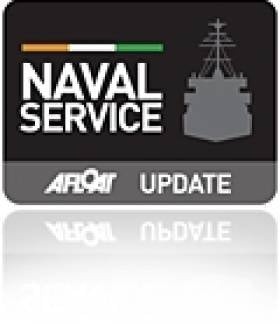Displaying items by tag: Queen Mary
Increased Naval Presence for Queen’s Visit
The most modern naval vessel of the eight-strong fleet the LÉ Niamh (P52) is an offshore patrol vessel (OPV) which is equipped with a bow-mounted 76mm gun. To see the crew undertake exercise-drills of the gun, watch the video below.
Former WW II Oil-Tanker Lays Cables Across Cork Harbour
To read further information about the cable installation project which is listed on the Port of Cork Company website under Notice to Mariners (No. 6 of 2011) click here.
The odd appearance of the barge masks a colourful and chequered career, as only a remnant of the original vessel survives (see photo). Only the forward section and bow (90m long X 20m beam) remain after the partial scrapping of the former oil tanker, Esso København, which took place nearly fifty years ago.
She was launched in 1930 as the MS Peter Hurll by the Palmers Shipbuilding and Iron Company Ltd (Yard/Hull no. 479) at Hebburn-on-Tyne, England. Measuring 11,952grt the tanker was commissioned for Baltisch-Amerik Petroleum Import G.m.b.H. (Waried Tankschiff Rhed.) of Danzig. For further details click here.
The vessel's profile was typical of the era, with a 'two-island' arrangement where the bridge superstructure is sited amidships and separated from the crew's accommodation quarters located aft on the poop deck at the stern.
At 452-foot long, the 17,585dwt vessel had a cargo carrying capacity of 138,108 barrels, which had an assigned pumping rate of 4,000 barrels an hour. The twin-screw diesel powered vessel had 5,300 brake horsepower engines that gave a speed of 12.3 knots.
In 1935 the vessel was sold to the Panama Transport Co. of Panama. While en route to Aruba, with an American crew, war was declared in Europe on September 3, 1939. At the Caribbean island's port of Las Piedras the Peter Hurll loaded her first war-time cargo of 106,514 barrels of fuel and crude oils bound for Everett, Mass.
Throughout the war years the Peter Hurll was crewed at various times between Americans and Danes. To read in greater detail the career history of the vessel and an account of the attempted U-Boat attack on the Peter Hurll click here. The tanker had several sisters, the F. H. Bedford Jr, J. H. Senior, J.A. Mowinckel and The Heinrich v. Riedemann which was lost on April 16, 1942.
Only a few months after the war in February 1946, the Peter Hurll bunkered the Queen Mary, which was moored alongside Pier 90 on the North River, New York. In less than 10 hours the vessel tranferred 27,797 barrels of fuel in a direct tanker-to-ship delivery of fuel oil. The famous 80,000 tonnes Cunard liner which like the tanker, was also built in 1930, had been recently re-converted from a troopship to her peacetime role as a passenger-liner.
In 1967 the liner retired and the vessel is moored at Long Beach, California, as a static hotel, restaurant and museum (see www.queenmary.com).
Two years later the Peter Hurll changed ownership to Det Danske Petroleums A/S of Copenhagen but later under the control of Dansk Esso A/S was renamed Esso København (see link) and the vessel was enlarged to a tonnage of 12,043grt.
In 1952, the vessel was taken to Odense, Denmark by H. J. Hansen, where the vessel was partially broken-up. The remaining fore-end survived and was rebuilt as a cable / pipe laying barge in 1963 (click here). The structure which essentially is a barge was named Henry P Lading for new owners, Nordisk Kabel og Traadfabrikker A/S, Copenhagen.
At one stage the barge was renamed "Nkt Cables a/S" but in 2002 the barge was sold to Jydsk Dykkerfirma ApS, now named JD Contractor A/S. The company (click here) is the largest underwater contractor in Denmark, providing diving assignments and the laying and embedding of submarine cables and pipelines worldwide.
Only late last year, scuba-divers found a fully intact World War I U-Boat on the seabed just outside Cork harbour. To read more about the U-Boat which sank some 93 years ago and photos click here.

























































